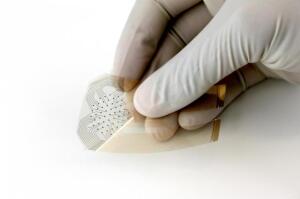by
Lauren Dubinsky, Senior Reporter | March 17, 2015
Bandages are not just for cuts anymore. The University of California, Berkeley is developing a “smart bandage” that can detect bed sores before they become visible.
"As technology gets more and more miniaturized, and as we learn more and more about the responses the body has to disease and injury, we're able to build bandages that are very intelligent," Michel Maharbiz, a UC Berkeley associate professor of electrical engineering and computer sciences and head of the smart-bandage project, said in a statement.
To create the bandage, the researchers printed many electrodes on a thin, flexible film and then sent a tiny electrical current between the electrodes to generate a spatial map of the underlying tissue, a technique known as impedance spectroscopy. When it’s functioning properly, the cell’s membrane is fairly impervious but when the cell begins to die, the cell wall starts to deteriorate and electrical signals can leak through.



Ad Statistics
Times Displayed: 77523
Times Visited: 2707 Ampronix, a Top Master Distributor for Sony Medical, provides Sales, Service & Exchanges for Sony Surgical Displays, Printers, & More. Rely on Us for Expert Support Tailored to Your Needs. Email info@ampronix.com or Call 949-273-8000 for Premier Pricing.
The researchers tested the bandage on rats by gently squeezing their bare skin between two magnets to create a pressure wound. The magnets were left in place for one to three hours while the rats went about their usual business.
After the magnets were removed, blood flow resumed, which caused inflammation and oxidative damage and in turn sped up cell death. The bandage was then used to gather data once a day for three days in order to track the wound’s progression.
They found that the bandage was able to effectively track varying degrees of tissue damage in the rat. Additionally, one hour of pressure caused mild and reversible tissue damage but three hours of pressure led to more serious and permanent injuries.
The researchers envision that the bandage can be used by nurses for spot-checking, or integrated into wound dressing to track how the wound is healing. This could be a major breakthrough for the industry since bed sores affect about 2.5 million Americans and contribute to $11 billion in costs annually, according to the study.
"It's tackling a big problem that many people have been trying to solve in the past 50 years,” Dr. Michael Harrison, a professor of surgery at UCSF and a co-investigator of the study, said in a statement. “As a clinician and someone who has struggled with this clinical problem, this bandage is great."

